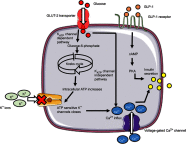Current perspective on the role of insulin and glucagon in the pathogenesis and treatment of type 2 diabetes mellitus
- PMID: 31191043
- PMCID: PMC6515536
- DOI: 10.2147/CPAA.S202614
Current perspective on the role of insulin and glucagon in the pathogenesis and treatment of type 2 diabetes mellitus
Abstract
According to the World Health Organization, 422 million adults worldwide live with diabetes mellitus (DM), a significant portion of whom have type 2 diabetes. The discovery of insulin as a key regulator of glucose metabolism has revolutionized our understanding of DM and provided several therapeutic avenues. Most studies have so far predominantly focused on the role of insulin in type 2 diabetes. However, the balance between insulin and glucagon is essential in ensuring glucose homeostasis. In this review, we begin by evaluating the principal differences between insulin and glucagon with regard to their mechanism and control of their secretion. Next, we discuss their mode of action and effects on metabolism. We further explore how the two hormones impact the natural history of type 2 diabetes. Finally, we outline how current and emerging pharmacological agents attempt to exploit the properties of insulin and glucagon to benefit patients with type 2 diabetes.
Keywords: glucagon; glucose; insulin; type 2 diabetes mellitus.
Conflict of interest statement
The authors report no conflicts of interest in this work.
Figures
Similar articles
-
Enteroinsular signaling: perspectives on the role of the gastrointestinal hormones glucagon-like peptide 1 and glucose-dependent insulinotropic polypeptide in normal and abnormal glucose metabolism.Curr Opin Clin Nutr Metab Care. 2003 Jul;6(4):461-8. doi: 10.1097/01.mco.0000078991.96795.84. Curr Opin Clin Nutr Metab Care. 2003. PMID: 12806222 Review.
-
CART is overexpressed in human type 2 diabetic islets and inhibits glucagon secretion and increases insulin secretion.Diabetologia. 2016 Sep;59(9):1928-37. doi: 10.1007/s00125-016-4020-6. Epub 2016 Jun 23. Diabetologia. 2016. PMID: 27338624
-
Normal secretion of the incretin hormones glucose-dependent insulinotropic polypeptide and glucagon-like peptide-1 during gestational diabetes mellitus.Gynecol Endocrinol. 2007 Jan;23(1):58-62. doi: 10.1080/09513590601137004. Gynecol Endocrinol. 2007. PMID: 17484514
-
Impaired incretin secretion and pancreatic dysfunction with older age and diabetes.Metabolism. 2014 Jul;63(7):922-9. doi: 10.1016/j.metabol.2014.04.004. Epub 2014 Apr 12. Metabolism. 2014. PMID: 24854384 Clinical Trial.
-
Glucose-dependent insulinotropic polypeptide: effects on insulin and glucagon secretion in humans.Dan Med J. 2016 Apr;63(4):B5230. Dan Med J. 2016. PMID: 27034187 Review.
Cited by
-
A perception that the feed grain basis of reduced-crude protein diets modifies the anabolic impact of insulin on the growth performance of broiler chickens.Anim Nutr. 2025 Mar 27;21:245-255. doi: 10.1016/j.aninu.2024.10.009. eCollection 2025 Jun. Anim Nutr. 2025. PMID: 40487105 Free PMC article. Review.
-
Bariatric Surgery and Gut-Brain-Axis Driven Alterations in Cognition and Inflammation.J Inflamm Res. 2023 Nov 22;16:5495-5514. doi: 10.2147/JIR.S437156. eCollection 2023. J Inflamm Res. 2023. PMID: 38026245 Free PMC article. Review.
-
PI3K/AKT/mTOR signaling participates in insulin-mediated regulation of pathological myopia-related factors in retinal pigment epithelial cells.BMC Ophthalmol. 2021 May 17;21(1):218. doi: 10.1186/s12886-021-01946-y. BMC Ophthalmol. 2021. PMID: 34001063 Free PMC article.
-
Association between osteocalcin, a pivotal marker of bone metabolism, and secretory function of islet beta cells and alpha cells in Chinese patients with type 2 diabetes mellitus: an observational study.Diabetol Metab Syndr. 2022 Oct 28;14(1):160. doi: 10.1186/s13098-022-00932-8. Diabetol Metab Syndr. 2022. PMID: 36307866 Free PMC article.
-
The sugar-responsive enteroendocrine neuropeptide F regulates lipid metabolism through glucagon-like and insulin-like hormones in Drosophila melanogaster.Nat Commun. 2021 Aug 10;12(1):4818. doi: 10.1038/s41467-021-25146-w. Nat Commun. 2021. PMID: 34376687 Free PMC article.
References
-
- Murlin JR, Clough HD, Gibbs CBF, Stokes AM. Aqueous extracts of the pancreas. Influence on the carbohydrate metabolism of depancreatized animals. J Biol Chem. 1923;56:253–296.
-
- Sutherland EW, De Duve C. Origin and distribution of the hyperglycemic-glycogenolytic factor of the pancreas. J Biol Chem. 1948;175(2):663–674. - PubMed
-
- Leclercq-Meyer V, Marchand J, Malaisse WJ. Calcium dependency of glucagon release: its modulation by nutritional factors. Am J Physiol. 1979;236(2):98–104. - PubMed
Publication types
LinkOut - more resources
Full Text Sources


